
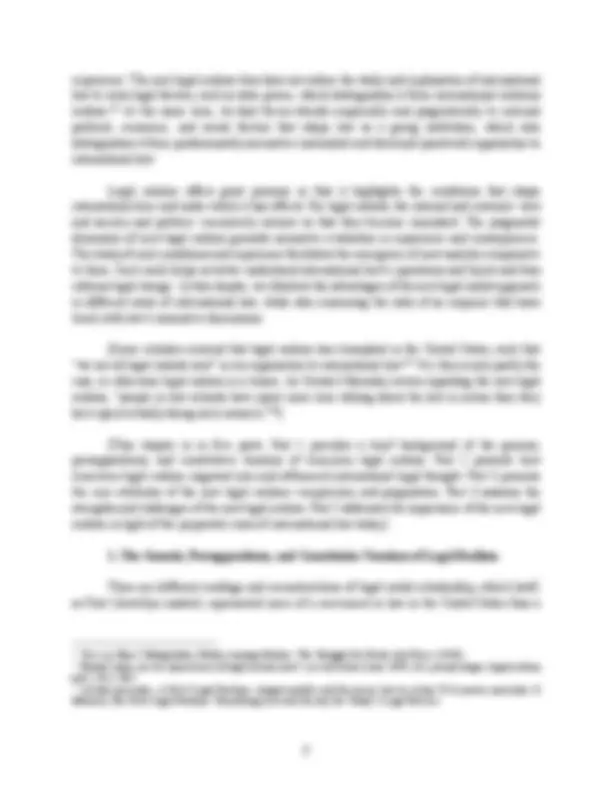
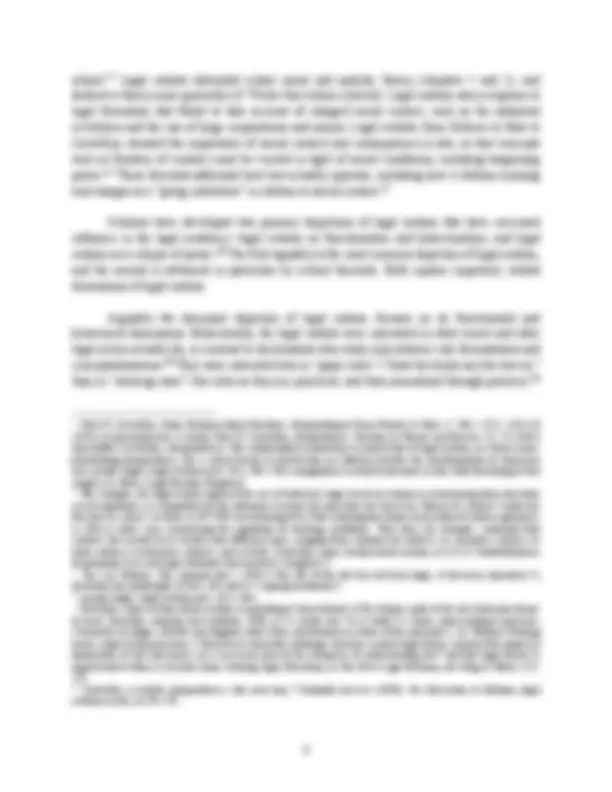
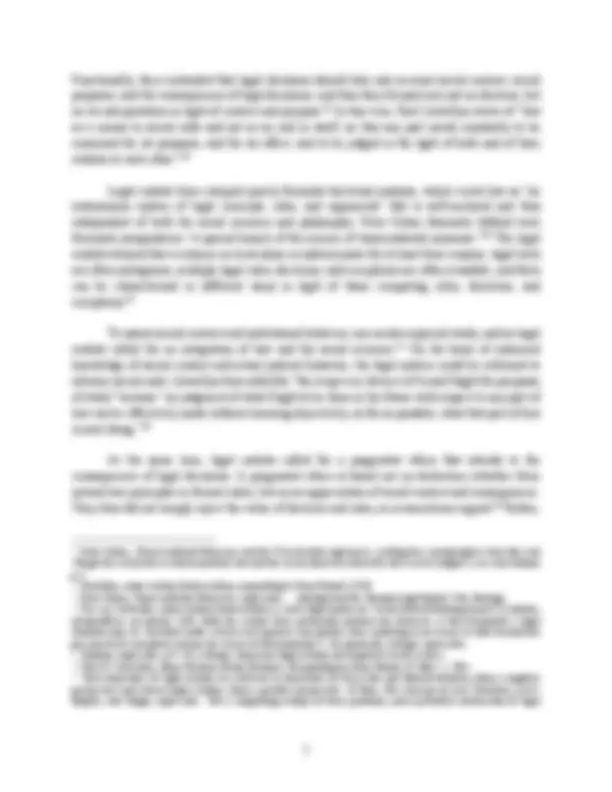
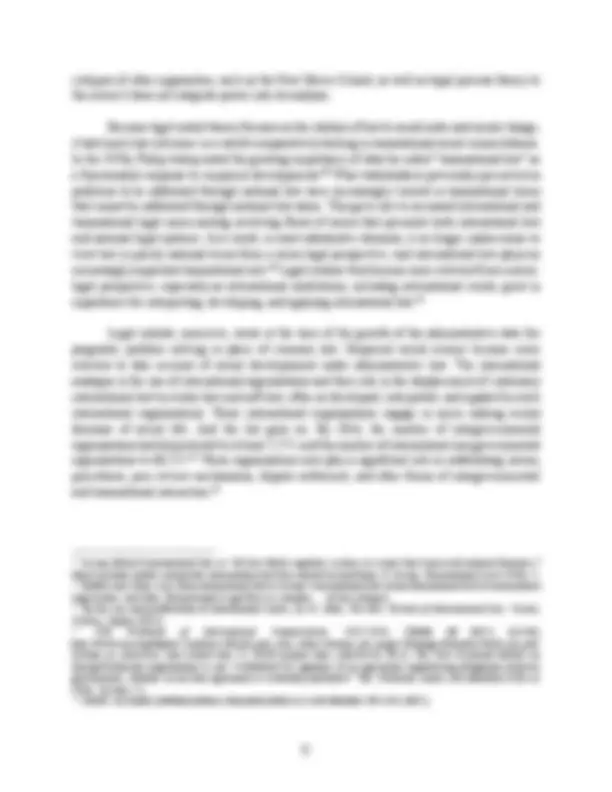
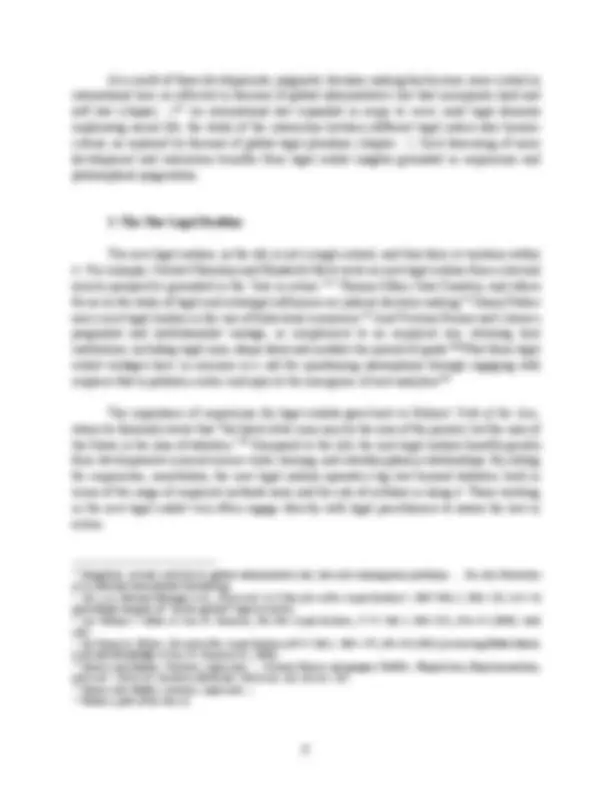
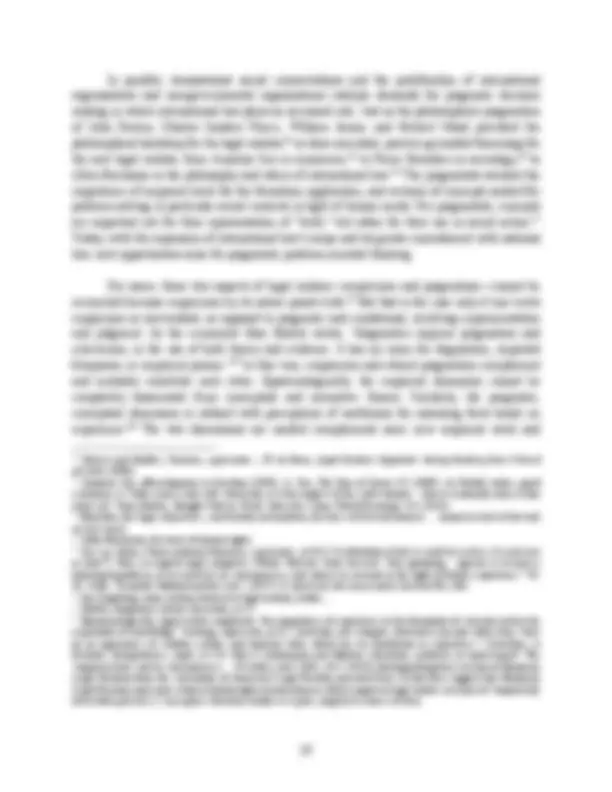
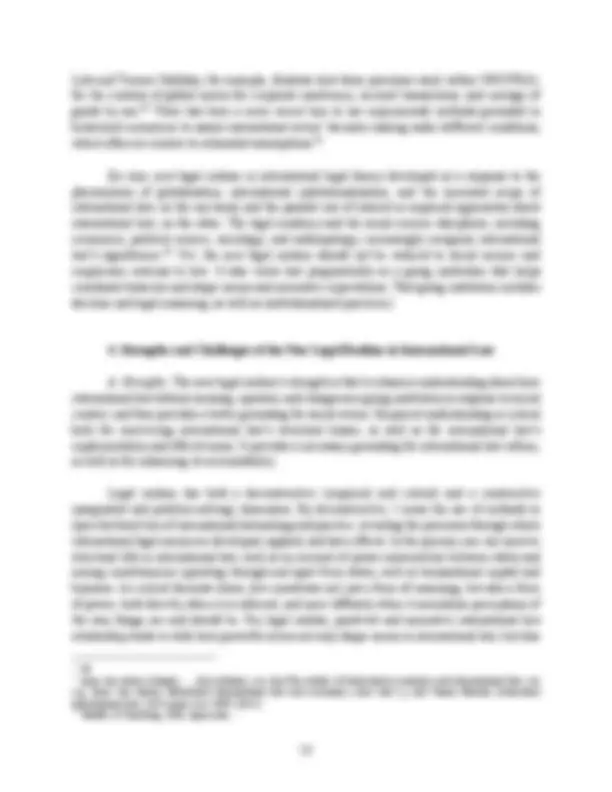
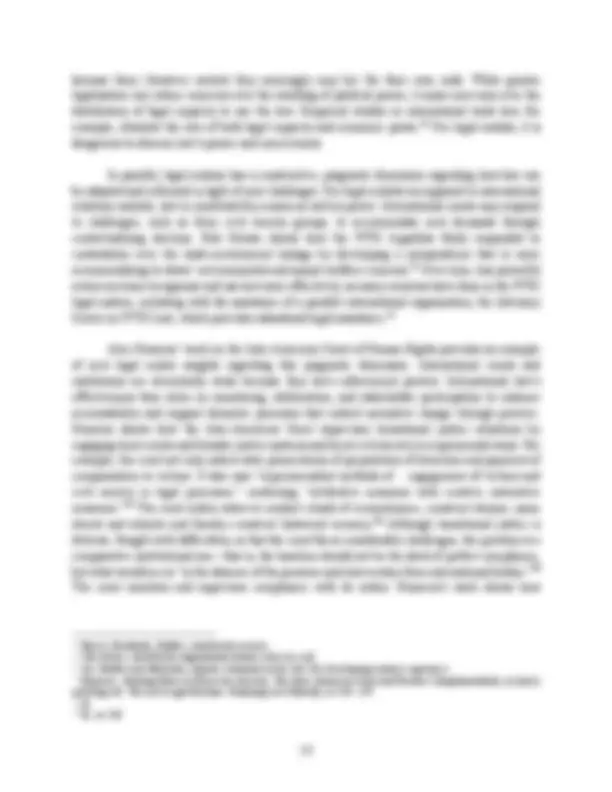
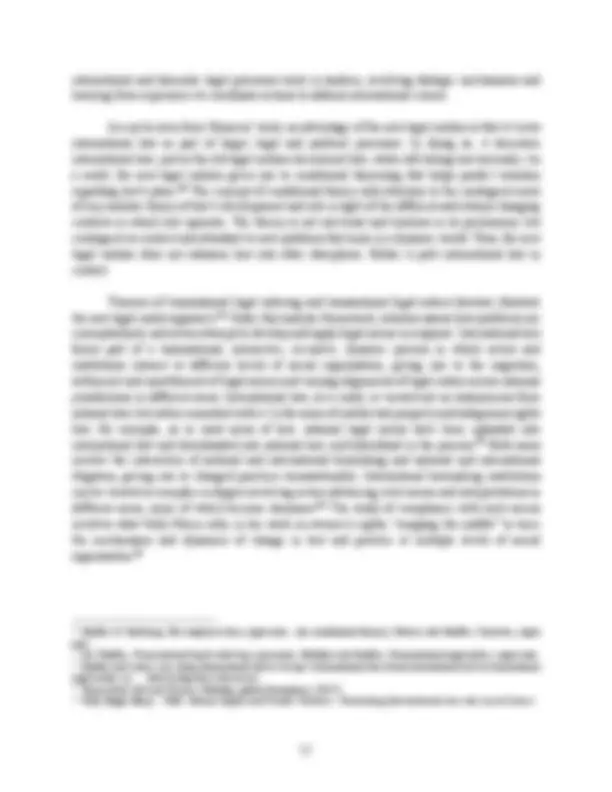
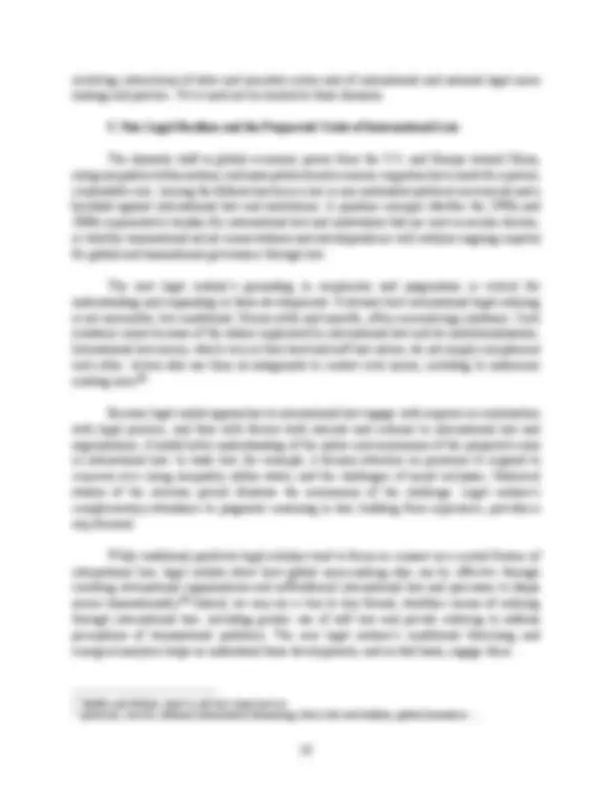


Study with the several resources on Docsity

Earn points by helping other students or get them with a premium plan


Prepare for your exams
Study with the several resources on Docsity

Earn points to download
Earn points by helping other students or get them with a premium plan
Community
Ask the community for help and clear up your study doubts
Discover the best universities in your country according to Docsity users
Free resources
Download our free guides on studying techniques, anxiety management strategies, and thesis advice from Docsity tutors
The development of legal realism in the context of international law. It highlights the importance of empiricism and pragmatist philosophy in understanding the interaction of internal and external aspects of law's development and application. The document also explores the influence of legal realism on international law theory after World War II and the rise of new legal realism in response to economic globalization and the expansion of international institutions. It concludes by emphasizing the importance of actors, norms, and power in relation to legal processes.
Typology: Lecture notes
1 / 18

This page cannot be seen from the preview
Don't miss anything!











Working draft
By Gregory Shaffer^1 (for the edited volume International Legal Theory ; to be around 8K words; Comments welcome regarding the clarity of the argument, organization, and examples, as well as what can be cut, such as the footnotes) There are three pillars of jurisprudence: moral theorizing (reflected in natural law); analytic theorizing (reflected in positivism); and law and society theorizing (reflected in legal realism).^2 Legal realism exemplifies this third approach to international law theory beyond natural law and positive law covered in chapters 1 and 2 , and it provides a foundation for many theoretical approaches in the chapters that follow. American legal realism grew out of and continues to have parallels with European socio-legal thought (sometimes referred to as European legal realism), as well as socio-legal thought around the world.^3 In its formative years in the 1930s and early 1940s, American legal realism did not engage with international law since international law lacked salience in the United States (U.S.) before the U.S. rise to global power, the creation of the United Nations and the Bretton Woods institutions, and U.S. engagement with international law in the context of the Cold War.^4 Some American legal realists, indeed mainly as an aside, questioned the place of international law in light of interstate struggles for power.^5 American legal realism nonetheless would exercise a profound influence on international law theory after World War II, beginning with the New Haven School of International Law (with its pragmatist, policy orientation), and including most of the other approaches addressed in this book, ranging from legal process to behavioralist to critical and third world theories of international law.^6 The progenitor of the New Haven School, Myres McDougal, in fact, was in the (^1) Gregory Shaffer is Chancellor’s Professor of Law, University of California, Irvine School of Law. (^2) Brian Tamanaha, A Realistic Theory of Law 30 (2017) (calling this third pillar “social legal theory”). (^3) For an application of Scandinavian legal realism and other European socio-legal thought to a new legal realist approach to international law that has parallels with the one in this chapter, see holtermann & madsen, European legal realism:…leiden j intl l (2015); and holtermann & madsen, high stakes and persistent challenges, leiden j intl law (2015). On the influence of European thought on the American legal realists, see e.g. Herget Y Stephen Wallace, the german free law movement as the source of American legal realism, 73 va l rev 399 (1987); E. Grisé et al, ‘Rudolf Von Jhering's Influence on Karl Llewellyn’, (2012) 48 Tulsa Law Review 93. (^4) See e.g. Laura Kalman, Legal Realism at Yale 1927-1960, 154, 181, 207, 217 (1986) (discussing the rise in international law courses at Harvard and Yale after World War II). (^5) Some legal realists questioned the very extent and existence of international law at the time. See e.g. Felix Cohen, Transcendental nonsense…, (“at least to the extent that nations have not effectively surrendered their power through compacts establishing such rudimentary agencies of international government as the League of Nations or the Universal Postal Union, there is in fact a state of nature and a war of all against all”), (^6) Kalman, supra note,… 229 (“the realists’ interest in social policy—nourished by the threat of conflagration at home and abroad during the era in which they lived—had resulted in a multitude of courses in public and international law”).
second generation of legal realists^7 and his early work directly invoked legal realism in responding to challenges to it from Lon Fuller.^8 With economic globalization and the expansion of international institutions after the collapse of the Soviet Union and the fall of the Berlin Wall, international law became of much greater salience. New international institutions, including international courts, proliferated, and international norm making—be it of a formally binding or informal soft-law nature—increasingly meshed with national law and practice across areas of social life, including almost all domains of human rights, regulatory, and business law. As a result, the social sciences became much more interested in international law and institutions, spurring empirical study of these developments. A new legal realism regarding international law rose in response. This new legal realism builds from the old in focusing on the interaction of internal “legal” and external “extra-legal” aspects of law’s development and application.^9 The new legal realism thus attends closely to the role of actors, norms, and power in relation to legal processes. Over the past dozen years, over seven hundred articles have used the term ‘new legal realism’,^10 and a symposium issue and an edited volume on new legal realism and international law were respectively published in 2015 and
2016.^11 The development of the new legal realism advances two dimensions for the study of international law and its relationship with national law and practice. On the one hand, the new legal realism stresses the importance of empiricism and a link to the social sciences. On the other hand, it has a pragmatic dimension, grounded in pragmatist philosophy, which attends to the importance of legal institutions, processes, norms, and practices in shaping social expectations and (^7) See e.g. Eugene Rostow, “Myres S. McDougal,” 84 Yale L.J. 704, 713 (1974) (“he ranks with the best of the realists in an effort which has characterized his work ever since, the scrupulous and critical reformulation of the rules of law in the light of the tests and tenets of realism”); Kalman, legal realism at yale 119 (^8) One of McDougal’s important early articles was “Fuller v. the American Legal Realists: An Intervention,” 50 Yale L.J 827 (1941) (“The American legal realism which Professor Fuller attacks is a bogus American legal realism….The major tenet of the "functional approach," which they have so vigorously espoused, is that law is instrumental only, a means to an end, and is to be appraised only in the light of the ends it achieves. Any divorce they may at times have urged between is and ought has been underscored always as temporary, solely for the purpose of preventing their preferences from obscuring a clear understanding of the ways and means”). (^9) See Howard Erlanger et al., Foreword: Is It Time for a New Legal Realism? , 2005 WIS. L. REV. 335 …; nourse and Shaffer, varieties of new legal realism; (^10) As of January 3, 2018, 703 documents were retrieved by the search “new legal realism” in Westlaw’s Journals and Law Reviews (JLR) database. This number understates actual interest, as some authors simply refer to this scholarship as “legal realism,” and Westlaw does not capture book chapters and non-legal publications. (^11) See Shaffer, The New Legal Realist Approach to International Law, leiden j intl l (introducing symposium issue); Shaffer, The New legal Realism’s Rejoinder,, leiden j intl law (2016) (responding to critiques by Jan Klabbers and Ino Augsburg in the subsequent issue); and introduction, heinz and merry The New Legal Realism: Studying Law Globally… (introducing an edited volume that addresses law and globalization, with a number of chapters focusing on international law in that context); and g Shaffer, new legal realism and international law, in The New Legal Realism: Studying Law Globally, eds. klug and merry.
school.^15 Legal realists distrusted extant moral and analytic theory (chapters 1 and 2), and deductive theory more generally (cf. Weiler this volume [check]). Legal realism was a response to legal formalism that failed to take account of changed social context, such as the industrial revolution and the rise of large corporations and unions. Legal realists, from Holmes to Hale to Llewellyn, stressed the importance of social context and consequences in law, so that concepts such as freedom of contract must be viewed in light of social conditions, including bargaining power.^16 These theorists addressed how law actually operates, including how it obtains meaning and changes as a “going institution” in relation to social context.^17 Scholars have developed two primary depictions of legal realism that have exercised influence in the legal academy—legal realism as functionalism and behavioralism, and legal realism as a critique of power.^18 The first arguably is the most common depiction of legal realism, and the second is advanced in particular by critical theorists. Both capture important, related dimensions of legal realism. Arguably the dominant depiction of legal realism focuses on its functionalist and behaviorist dimensions. Behaviorally, the legal realists were interested in what courts and other legal actors actually do, in contrast to doctrinalists who study only abstract rule formulations and conceptualizations.^19 They were interested less in “paper rules” (“what the books say the law is),” than in “working rules” (the rules as they are practiced, and thus normalized through practice).^20 (^15) Karl N. Llewellyn, Some Realism About Realism—Responding to Dean Pound, 44 Harv. L. Rev. 1222, 1233– 34 (1931) (a movement not a school); Karl N. Llewellyn, Jurisprudence: Realism in Theory and Practice 53, 54 (1962) [hereinafter Llewellyn, Jurisprudence]. For a philosophical naturalist reconstruction of legal realism, see brian Leiter, naturalizing jurisprudence; for a critical theory reconstruction see Morton horwitz, the transformation of American law; joseph singer, legal realism now, CA L Rev. For a pragmatist reconstruction more in line with theorizing in this chapter see Been, Legal Realism Regained (^16) For example, the legal realists opposed the use of deductive logic based on axioms in overturning labor and other social regulation, as exemplified by the infamous Lochner decision that was based on “liberty of contract” under the due process clause. Lockner vs NY 1905 (overturning New York working time limits on freedom of contract grounds), as well as other cases overturning the regulation of working conditions. They thus, for example, contended that contract law needed to be broken into different types, ranging from commercial contract, to consumer contract, to labor contract, to franchise contract, and so forth. Llewellyn, some realism about realism, at [151] (“worthwhileness of grouping cases and legal situations into narrower categories”). (^17) See e.g., Holmes, The common law 1 (1881) (“the life of the law has not been logic; it has been experience”); llewellyn, my philosophy of law, 183 (law as “a going institution”). (^18) joseph singer, legal realism now, CA L Rev. (^19) llewellyn, some realism about realism, responding to Dean Pound, [150]; holmes, path of the law (bad man theory of law); llewellyn common law tradition, 1960, at 51 (study law “as it works”); cohen, transcendental nonsense, (“behavior of judges, sheriffs and litigants rather than conventional accounts of the principle”). As William Twining writes, legal realism presents a “theoretical claim that challenges doctrine-centred legal theory: namely that empirical dimensions of law and justice are a necessary part of the enterprise of understanding law” and that legal theory is impoverished when it excludes them. twining, legal R/realism, in The New Legal Realism, eds Klug & Merry 122- 123 (^20) Llewellyn a realistic jurisprudence—the next step,” Columbia law rev (1930). See discussion in Kalman, legal realism at yale, at 234-235.
Functionally, they contended that legal decisions should take into account social context, social purposes, and the consequences of legal decisions, and thus they focused not just on doctrine, but on its interpretation in light of context and purpose.^21 In this vein, Karl Llewellyn wrote of “law as a means to social ends and not as an end in itself; so that any part needs constantly to be examined for its purposes, and for its effect, and to be judged in the light of both and of their relation to each other.”^22 Legal realists thus critiqued purely formalist doctrinal analysis, which views law as “an autonomous system of legal concepts, rules, and arguments” that is self-enclosed and thus independent of both the social sciences and philosophy. Felix Cohen famously dubbed such formalist jurisprudence “a special branch of the science of transcendental nonsense.”^23 The legal realists stressed that a reliance on texts alone is indeterminate for at least three reasons: legal texts are often ambiguous; multiple legal rules, doctrines, and exceptions are often available; and facts can be characterized in different ways in light of these competing rules, doctrines, and exceptions.^24 To assess social context and institutional behavior, one needs empirical study, and so legal realists called for an integration of law and the social sciences.^25 On the basis of enhanced knowledge of social context and actual judicial behavior, the legal system could be reformed to advance social ends. Llewellyn thus called for “the temporary divorce of Is and Ought for purposes of study” because “no judgment of what Ought to be done in the future with respect to any part of law can be effectively made without knowing objectively, as far as possible, what that part of law is now doing.”^26 At the same time, legal realists called for a pragmatist ethics that attends to the consequences of legal decisions. A pragmatist ethics is based not on deduction (whether from natural law principles or formal rules), but on an appreciation of social context and consequences. They thus did not simply reject the value of doctrine and rules, as is sometimes argued.^27 Rather, (^21) felix Cohen, Transcendental Nonsense and the Functionalist Approach ,..(calling for a jurisprudence that does not “forget the social forces which mold the law and the social ideals by which the law is to be judged”); see also kalman p 3 (^22) llewellyn, some realism about realism, responding to Dean Pound, [150] (^23) felix Cohen, Transcendental Nonsense, supra note…. (taking from the German legal thinker Von Jhering). (^24) See e.g. Llewellyn, some realism about realism (); cook (legal norms are “in the habit of hunting in pairs”); yntema, jurisprudence on parade 1169 (what the realists have pertinently pointed out, however, is that frequently a legal situation may be classified under several such general conceptions, thus rendering it necessary to look beyond the preconceived conceptual scheme for a basis of determination”). See generally schlegel, supra note.. (^25) Kalman, supra note, p17-18; schlegel, American legal realism and empirical social science (^26) Karl N. Llewellyn, Some Realism About Realism—Responding to Dean Pound, 44 Harv. L. Rev. (^27) Such depictions of legal realism are reflected in depictions by HLA hart and Ronald dworkin, from a negative perspective and critical legal scholars, from a positive perspective. Cf Hart, The Concept of Law; Dworkin, Law’s Empire; and Singer, supra note…For a compelling critique of these positions, and a powerful construction of legal
doctrinal and legislative intervention. Deductive logic, they contended, cannot determine interpretive choices, but rather consideration of legal purpose and consequence, involving policy, is inevitable.^35 2. Migration into and influence on international legal thought Although the original legal realists did not address international law, their approach migrated into international legal thought, influencing many of the international law theories that arose after World War II. Given the relative dearth of judicial doctrine in international law during the formative years of legal realism, non-doctrinal approaches borrowed from legal realism in different ways. Chronologically, the New Haven School, also known as “policy science,” represented a first development of legal realism in light of international law challenges during the Cold War.^36 Its aim was to formulate policy goals that the law should pragmatically pursue, while attending to the importance of context and process.^37 Subsequent developments of non-doctrinal approaches to international law likewise had roots in legal realism, including transnational legal process theory, critical international legal theory, rationalist approaches to international law (such as law and economics), sociological approaches to international law, feminist and third world approaches to law, as well as some aspects of interpretivist (rights) theory. For example, legal process theorists focus on law’s purposiveness and on reasoned elaboration for functional problem solving, as opposed to deductive reasoning. Rationalist approaches such as that of law and economics focus on social policy goals, such as efficiency and wealth maximization. Interpretivist theorists focus on purpose, involving the elaboration of principles that mediate fit (in light of past decisions—i.e. tradition) and justification (in terms of principles of justice—i.e. progress).^38 Critical legal studies theorists stress the inevitability of value choices in legal decision making. Legal realism’s pragmatic focus on power and coercion is thus central to many of the international law theories in this book, from critical to feminist to third world approaches to international law. It is likewise important for (^35) As the philosopher Morris Cohen wrote regarding contract law, “A contract… between two or more individuals cannot be said to be generally devoid of all public interest…. Enforcement, in fact, puts the machinery of the law in the service of one party against the other. When that is worthwhile and how that should be done are important questions of public policy.” Morris cohen, the basis of contract, harv l rev, at 562. See also Robert hale, coercion and distribution… at 477 (^36) See H. D. Lasswell and M. S. McDougal, Jurisprudence for a free society: studies in law, science and policy (1992); M. Reisman, S. Wiessner, and A. Willard, ‘ Commentary : The New Haven School: A Brief Introduction’, (2007) 32 The Yale Journal of International Law , 575. See also Koh, chapter… (this volume). (^37) Rostow, supra note…, at 717 (McDougal and his partner Harold Lasswell aimed “to transform the sociological- functional jurisprudence of the Realist generation into a jurisprudence of values.”). See also Myres McDougal, The law school of the future: From legal realism to policy science in the world community (1947). (^38) See e.g. dworkin, law’s empire. For an application to international law, see [cali, on interpretivism and international law, EJIL and Venzke, chapter … (this volume)
critiques of other approaches, such as the New Haven School, as well as legal process theory to the extent it does not integrate power into its analysis. Because legal realist theory focuses on the relation of law to social order and social change, it had much less relevance in a world comparatively lacking in transnational social connectedness. In the 1950s, Philip Jessup noted the growing importance of what he called “transnational law” as a functionalist response to empirical developments.^39 What stakeholders previously perceived as problems to be addressed through national law were increasingly viewed in transnational terms that cannot be addressed through national law alone. This gave rise to increased international and transnational legal norm-making involving flows of norms that permeate both international law and national legal systems. As a result, in most substantive domains, it no longer makes sense to view law in purely national terms from a socio-legal perspective, and international law plays an increasingly important transnational role.^40 Legal realism thus became more relevant from a socio- legal perspective, especially as international institutions, including international courts, grew in importance for interpreting, developing, and applying international law.^41 Legal realists, moreover, wrote at the time of the growth of the administrative state for pragmatic problem solving in place of common law. Empirical social science became more relevant to take account of social developments under administrative law. The international analogue is the rise of international organizations and their role in the displacement of customary international law by treaty law and soft law, often as developed, interpreted, and applied by such international organizations. These international organizations engage in norm making across domains of social life. And the list goes on. By 2016, the number of intergovernmental organizations had skyrocketed to at least 7,757, and the number of international non-governmental organizations to 60,272.^42 These organizations now play a significant role in establishing norms, procedures, peer review mechanisms, dispute settlement, and other forms of intergovernmental and transnational interaction.^43 (^39) Jessup defined transnational law as “all law which regulates actions or events that transcend national frontiers,” which includes public and private international law but extends beyond them. P. Jessup, Transnational Law (1956), 2. (^40) Shaffer and carlos coye, from international law to Jessup’s transnational law, from transnational law to transnational legal orders; and Koh, Transnational Legal Process (chapter … of this volume). (^41) On the rise and proliferation of international courts, see K. Alter, The New Terrain of International Law: Courts, Politics, Rights (2014). (^42) UIA Yearbook of International Organizations 2015 - 2016 , UNION OF INT’L ASS’NS, http://www.uia.org/allpubs?combine=&field_pub_year_value=&items_per_page=20&page=8&order=field_uia_pub lication_nr_&sort=asc (last visited July 25, 2016) (reports data collected in 2014). The UIA Yearbook defines an intergovernmental organization as one “established by signature of an agreement engendering obligations between governments, whether or not that agreement is eventually published.” The Yearbook counts self-identified IGOs as IGOs. Section 1.3. (^43) JOSE E. ALVAREZ, INTERNATIONAL ORGANIZATIONS AS LAW-MAKERS 589 - 619 (2005).
In parallel, transnational social connectedness and the proliferation of international organizations and non-governmental organizations catalyze demands for pragmatic decision making in which international law plays an increased role. Just as the philosophical pragmatism of John Dewey, Charles Sanders Pierce, William James, and Herbert Mead provided the philosophical backdrop for the legal realists,^51 so does non-ideal, practice-grounded theorizing for the new legal realists, from Amartya Sen in economics,^52 to Pierre Bourdieu in sociology,^53 to Allen Buchanan in the philosophy and ethics of international law.^54 The pragmatists stressed the importance of empirical work for the formation, application, and revision of concepts needed for problem-solving in particular social contexts in light of human needs. For pragmatists, concepts are important not for their representation of “truth,” but rather for their use in social action.^55 Today, with the expansion of international law’s scope and its greater enmeshment with national law, new opportunities arise for pragmatist, problem-oriented thinking. For some, these two aspects of legal realism—empiricism and pragmatism—cannot be reconciled because empiricism by its nature posits truth.^56 But that is the case only if one views empiricism as universalist, as opposed to pragmatic and conditional, involving experimentation and judgment. As the economist Dani Rodrik writes, “diagnostics requires pragmatism and eclecticism, in the use of both theory and evidence. It has no room for dogmatism, imported blueprints, or empirical purism.”^57 In this vein, empiricism and ethical pragmatism complement and mutually constitute each other. Epistemologically, the empirical dimension cannot be completely dissociated from conceptual and normative frames. Similarly, the pragmatic, conceptual dimension is infused with perceptions of usefulness for assessing facts based on experience.^58 The two dimensions are needed complements since new empirical work and (^51) Nourse and Shaffer, Varieties, supra note .; W. de Been, Legal Realism Regained: Saving Realism from Critical Acclaim (2008). (^52) Amartya Sen, dEveelopment as freedom (1999); A. Sen, The Idea of Justice 85 (2009). As Rodrik writes, good economics is “both science and craft. Ironically, it is the neglect of the craft element… that occasionally turns it into snake oil.” Dani Rodrik, Straight Talk on Trade: Ideas for a Sane World Economy 145 (2018). (^53) Bourdieu, the logic of practice ; and dezalay and madsen, the force of law and lawyers…. annual review of law and social science (^54) Allen Buchanan, the heart of human rights (^55) See e.g. Cohen, Transcendental Nonsense, supra note , at 835 (“A definition of law is useful or useless. It is not true or false ”). Thus, as regards legal categories, Walter Wheeler Cook stressed, “Any grouping… appears as at most a working hypothesis, to be tested by its consequences, and subject to revision in the light of further experience.” W. W. Cook, ‘Scientific Method and the Law’, (1927) 13 American Bar Association Journal 303, 306. (^56) Ino Augsburg, some realism about new legal realism, leiden… (^57) Rodrik, diagnostics before discretion, at 37- (^58) Epistemologically, legal realists emphasize “the importance of experience in the formation of concepts and to the acquisition of knowledge.” twining, supra note, p123. Llewellyn, for example, distrusted concepts when they “take on an appearance of solidity, reality, and inherent value which has no foundation in experience.” Llewellyn, A Realistic Jurisprudence, supra, at 453. But cf. holtermann and Madsen, toleration, synthesis or replacement? The ‘empirical turn’ and its consequences… 29 leiden j intl l 1001, 1017 (2016) (distinguishing their version of European Legal Realism from the conception of American Legal Realism presented here in that they suggest that European Legal Realism represents a form of philosophical naturalism in which empirical legal studies, in terms of “empirically observable practices,” can replace doctrinal studies as a pure, empirical science of law).
pragmatic practice are always required to address new factual contexts and new questions. Empirics are needed to inform pragmatic decision-making. Pragmatic demands for decision- making inform the empirical questions asked. Empiricism needs concepts, and concepts need to be updated pragmatically in response to changes in the world so as to pursue normative goals. One foil for the new legal realists has been the rise of a new formalism in legal scholarship, including a reliance on simplistic rationalist presuppositions.^59 Law and economics, for example, becomes a target when it assumes away the complexity of the social world and uses models unreflexively for prescriptions. It risks becoming, to take from Roscoe Pound, a new form of “mechanical jurisprudence.”^60 On the surface, law and economics appears to be the opposite of the old formalism because it is not focused on developing a science of legal doctrine, but it can parallel the old formalism in its form of reasoning and substantive prescriptions. As Arthur Leff noted in reviewing Judge Posner’s Economic Analysis of Law , [I]t must immediately be noted, and never forgotten, that [Judge Posner’s] basic propositions are really not empirical propositions at all. They are all generated by “reflection” on an “assumption” about choice under scarcity and rational maximization.... Nothing merely empirical could get in the way of such a structure because it is definitional. That is why the assumptions can predict how people behave: in these terms there is no other way they can behave.^61 The experience of the 2007- 2008 financial crisis pressed many scholars, including Judge Posner, to rethink neoclassical law and economics’ most insistent assumptions,^62 a reflexive process that itself characterizes the new legal realism. When done well, empirical work helps counter biases not only in conventional understandings of international law, but also in scholars themselves. As Beth Mertz writes, “the power of social science methodology [is] to push us beyond our personal politics or situations, to enforce a form of humility in which we must listen to voices other than our own.”^63 This reflexive checking of bias is particularly important given that much of international law has been written by and from the perspectives of the Global North, as captured in third world approaches to international law (chapter…). This process of empirical investigation presses us to see freshly. (^59) Nourse and Shaffer, varieties at 105; Twining, Legal R/realism, supra note… 123 (“the foil to empiricism is rationalism, which emphasizes instead the importance of thought and knowledge of material that is in some sense independent of experience.”) (^60) Cf. Roscoe Pound, mechanical jurisprudence, Columbia law rev…(1908). (^61) Arthur Allen Leff, Commentary, Economic Analysis of Law: Some Realism About Nominalism , 60 VA. L. REV. 451, 457 (1974) (emphasis omitted). (^62) See e.g. RICHARD A. POSNER, A FAILURE OF CAPITALISM: THE CRISIS OF ’08 AND THE DESCENT INTO DEPRESSION 260 (2009). (^63) Elizabeth Mertz, Challenging Translations: New Legal Realist Methods, wisc law rev 482, 483 (2005)
Lieb and Terence Halliday, for example, illustrate how these processes work within UNCITRAL for the creation of global norms for corporate insolvency, secured transactions, and carriage of goods by sea.^71 There has been a more recent turn to use experimental methods grounded in behavioral economics to assess international actors’ decision making under different conditions, which often are counter to rationalist assumptions.^72 [In sum, new legal realism in international legal theory developed as a response to the phenomenon of globalization, international institutionalization, and the increased scope of international law, on the one hand, and the parallel rise of interest in empirical approaches about international law, on the other. The legal academy and the social science disciplines, including economics, political science, sociology, and anthropology, increasingly recognize international law’s significance.^73 Yet, the new legal realism should not be reduced to social science and empiricism external to law. It also views law pragmatically as a going institution that helps coordinate behavior and shape norms and normative expectations. That going institution includes doctrine and legal reasoning, as well as institutionalized practices.] 4. Strengths and Challenges of the New Legal Realism in International Law A. Strengths. The new legal realism’s strength is that it enhances understanding about how international law obtains meaning, operates, and changes as a going institution in response to social context, and thus provides a better grounding for social action. Empirical understanding is critical both for uncovering international law’s structural biases, as well as for international law’s implementation and effectiveness. It provides a necessary grounding for international law reform, as well as for enhancing its accountability. Legal realism has both a deconstructive (empirical and critical) and a constructive (pragmatist and problem-solving) dimension. By deconstructive, I mean the use of methods to open the black box of international lawmaking and practice, revealing the processes through which international legal norms are developed, applied, and have effects. In the process, one can uncover structural tilts in international law, such as on account of power asymmetries between states and among constituencies operating through and apart from states, such as transnational capital and business. As critical theorists stress, law constitutes not just a form of reasoning, but also a form of power, both directly when it is enforced, and more diffusely when it normalizes perceptions of the way things are and should be. For legal realists, positivist and normative international law scholarship tends to elide how powerful actors not only shape norms in international law, but also (^71) Id. (^72) anna van aaken (chapter …, this volume); see also For studies of behavioral economics and international law, see e.g. Anne van Aaken, Behavioral International law and economics, harv intl l j; and Tomer Broude, behavioral international law, 163 u penn l rev 1099 (2015) (^73) Shaffer & Ginsberg, AJIL supra note…
harness them (however neutral they seemingly may be) for their own ends. While greater legalization can reduce concerns over the wielding of political power, it raises new ones over the distribution of legal capacity to use the law. Empirical studies in international trade law, for example, illustrate the role of both legal capacity and economic power.^74 For legal realists, it is dangerous to obscure law’s power and coerciveness. In parallel, legal realism has a constructive, pragmatic dimension regarding how law can be adapted and reformed in light of new challenges. For legal realists (as opposed to international relations realists), law is constituted by reason as well as power. International courts may respond to challenges, such as from civil society groups, to accommodate new demands through contextualizing doctrine. Rob Howse shows how the WTO Appellate Body responded to contestation over the trade-environment linkage by developing a jurisprudence that is more accommodating to states’ environmental and animal welfare concerns.^75 Over time, less powerful actors can learn to organize and use law more effectively, as many countries have done in the WTO legal system, including with the assistance of a parallel international organization, the Advisory Centre on WTO Law, which provides subsidized legal assistance.^76 Alex Huneeus’ work on the Inter-American Court of Human Rights provides an example of new legal realist insights regarding this pragmatic dimension. International courts and institutions are structurally weak because they lack enforcement powers. International law’s effectiveness thus relies on monitoring, deliberation, and stakeholder participation to enhance accountability and support domestic processes that embed normative change through practice. Huneeus shows how the Inter-American Court supervises transitional justice situations by engaging local courts and broader justice systems and local civil society in experimental ways. For example, the court not only orders state prosecutions of perpetrators of atrocities and payment of compensation to victims. It also uses “experimentalist methods of… engagement of victims and civil society in legal processes,” combining “retributive measures with creative restorative measures.”^77 The court orders states to conduct rituals of remembrance, construct shrines, name streets and schools and thereby construct historical memory.^78 Although transitional justice is delicate, fraught with difficulties, so that the court faces considerable challenges, the question is a comparative institutional one—that is, the baseline should not be the ideal of perfect compliance, but what would occur “in the absence of the pressure and intervention from international bodies.”^79 The court monitors and supervises compliance with its orders. Huneeus’s work shows how (^74) Busch, Reinhardt, Shaffer, world trade review; (^75) Cite howse, world trade organization twenty years on, ejil; (^76) See Shaffer and Melendez, dispute settlement at the wto: the developing country experience (^77) Huneeus , Pushing States to Prosecute Atrocity: The Inter-American Court and Positive Complementarity, in merry and klug eds. The new Legal Realism: Studying Law Globally, at 228- 229 (^78) id (^79) id., at 236
B. Challenges and Responses. A frequent challenge to the new legal realism is the risk of reductionism and scientism in which law is subsumed within other disciplines.^85 Empiricism as a concept has many connotations. One idea it connotes is science, as reflected in the new “empirical legal studies” movement with its large-N regression analyses.^86 By calling something “science,” one asserts an authority while potentially obscuring assumptions on which findings depend. Such a science risks hiding normative claims implicit in the categories used. Moreover, social scientists trained in particular disciplines tend to use their own disciplinary tropes, which can be quite alien to the law. The new legal realism thus stresses the importance of bridge building, not surrender.^87 Disciplinary subsumption leaves very little room for the distinctively legal in legal institutions, legal professions, legal consciousness, and legal modes of discourse involving law’s particular craft and particular traditions. Instead, as Beth Mertz emphasizes, the project of new legal realism addresses the translation between social science and law, and provides a “sophisticated conversation about the process of translation itself.”^88 The new legal realism embraces multi- disciplinarity and, in doing so, provides a bridge to the other social sciences, opening research agendas, including joint ones, that are reflexive about their theoretical assumptions International law involves doctrine and so a related challenge is whether legal realism deprives law “of the very features that make it a distinctive enterprise.”^89 One response is that doctrine forms only a small part of international law. Yet, the new legal realists, as the old, also provide important insights for doctrinal analysis by focusing on the processes of reasoning and the factual contexts with which reasoning engages. On the one hand, as Hanoch Dagan contends, legal realists take formal law seriously (such as legal reasoning, craft, and tradition in the form of precedent), and yet counterbalances them, in each case, with taking equally seriously extra-legal concerns that inform law, such as power, empirics, and forward-looking goals and policies.^90 On (^85) See e.g. Martti Koskenniemi, “The Politics of International Law – 20 Years Later,” European Journal of International Law, Vol. 20, No. 1 (2009a), pp. 7-19; Martti Koskenniemi, “Law, Teleology and International Relations: An Essay in Counterdisciplinarity,” International Relations, Vol. 26, No. 1 (2012), pp. 3-34. An overlapping, but not identical, indictment of political science can be found in the work of Koskenniemi’s University of Helsinki colleague Jan Klabbers; see e.g. Jan Klabbers “The Relative Autonomy of International Law or The Forgotten Politics of Interdisciplinarity,” Journal of International Law & International Relations, Vol. 1, Nos. 1- 2 (2004-2005), pp. 35-48, and Jan Klabbers, “The Bridge Crack’d: A Critical Look at Interdisciplinary Relations,” International Relations, Vol. 23, No. 1 (2009), pp. 119- 25 ; andrea bianchi, international law theory 126-131. (^86) See Mertz and Suchman, a new legal empiricism: assessing ELS and NLR, annual review of law & social science (distinguishing empirical legal studies and new legal realism). (^87) Huneeus, human rights between jurisprudence and social science, leiden j; Erlanger et al, supra note… (^88) See Elizabeth Mertz, Introduction to The Role of Social Science in Law xiii–xxx (Elizabeth Mertz ed., 2008); Elizabeth Mertz, Translating Science into Family Law: An Overview, 56 DePaul L. Rev. 799, 801 (2007) (“An adequate translation of social science to law must look at the intervening steps just as systematically and carefully as it looks at the initial findings.”). (^89) Daniel bodansky, legal realism and its discontents, leiden j intl l (2015) (^90) Dagan, realist conception, supra note… see also Leiter, naturalizing jur 21 (core claim that “judges respond primarily to the stimulus of facts”)
the other hand, empirical analysis (including, more broadly, situation-sense) is critical for the factual questions to which law is applied. In much litigation before the World Trade Organization, for example, economic analysis of data is used. That data alone, however, is not determinative because it is assessed through legal categories that shape how it is understood and applied.^91 Finally, legal realism has long been critiqued for its failure to provide a theory of values. As Felix Cohen wrote, “we never shall thoroughly understand the facts as they are, and we are not likely to make much progress towards such understanding unless we at the same time bring into play a critical theory of values.”^92 The legal realist does not engage in ideal normative theory, yet notes the importance of values in orienting social action, which must have a critical dimension that questions the existing order and law’s tendency to preserve the status quo. Legal realists recognize that human values are “pluralistic and multiple, dynamic and changing, hypothetical and not self- evident, problematic rather than determinative,”^93 and yet not all values will do, particularly those not focused on human needs.^94 For a pragmatist, ultimate claims will always be contentious and subject to contestation, and thus legal realists stress the importance of participation of affected stakeholders.^95 Legal realists may begin with different normative frameworks that inform our ends as applied to different contexts, but what they commonly contend is that those ends should be responsive to experience.^96 As pragmatists, they maintain that thought is both purposive and derived from experience. Learning from the consequences of our interventions, we should be open to modifying our means, as well as our ends, which should be regarded as “ends-in-view.”^97 Legal realism thus can be complemented by other normative theories, such as those advanced in global constitutionalism, global administrative law, and legal pluralism, so long as they retain a pragmatist orientation with a critical dimension. Given its socio-legal orientation, legal realist scholarship has less frequently addressed high politics international law issues regarding interstate relations, such as over issues of territory and war and peace. It has more frequently addressed issues implicating economic and social life, (^91) see Andrew lang, new legal realism, empiricism, and scientism… leiden j of intl law (^92) Transcendental nonsense, at 848–49. (^93) Hessel Yntema, Jurisprudence on parade (1941) 39 Mich L Rev 1154, 1169. (^94) In my work, I have stressed the value of human liberty in terms of “furthering people’s real-life capacities” See Nourse and Shaffer, varieties, supra note…, at 135 (adopting Sen’s conception of liberty, and citing Sen, Ideals of Justice…). Sen’s conception has parallels with non-domination theory, as developed by Philip Petit. See PHILIP PETTIT, REPUBLICANISM: A THEORY OF FREEDOM AND GOVERNMENT 80 – 109 (1997). See also Hessel Yntema, the rational basis of legal science (1931) 31 Colum L Rev 925, 955 (“ideals of justice not related to human needs are not true ideals”). (^95) Because of the dynamic, pluralist nature of norm conception, participation and deliberation are also critically important for the new legal realism. Nourse and Shaffer, varieties, surpa note… at 1 23 - 127. (^96) See J. Dewey, Essays in Experimental Logic (1916); Nourse and Shaffer, Varieties, supra note … (^97) See, e.g., Dewey, Valuation and Experimental Knowledge, in Middle Works (1922); Theory of Valuation, in Later Works (1939).